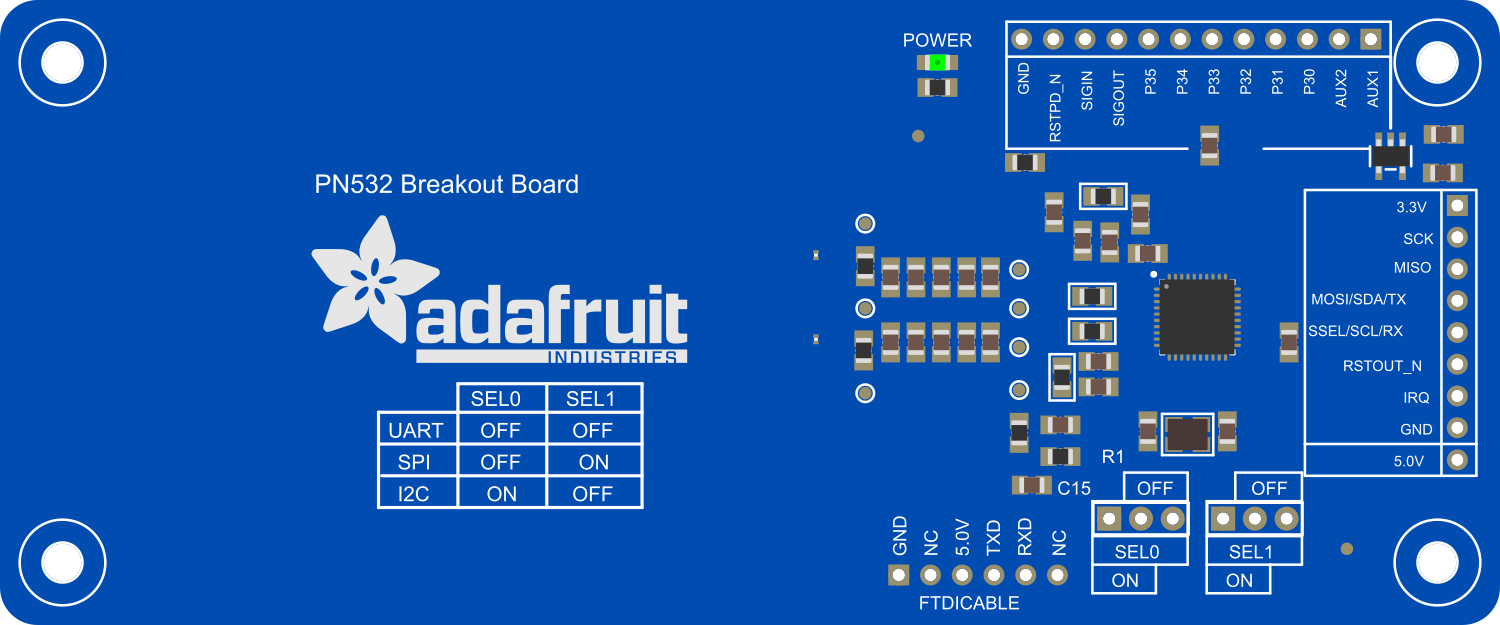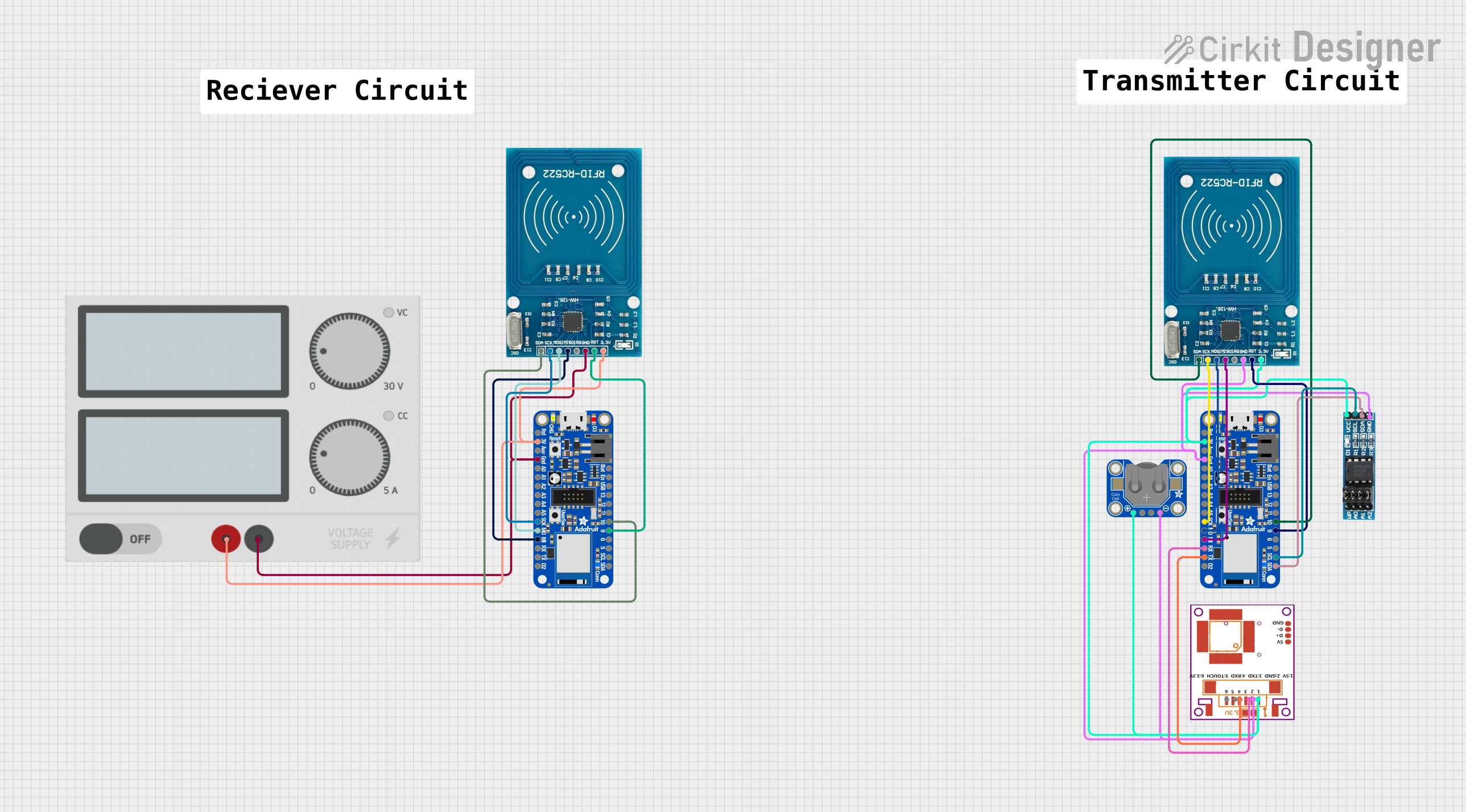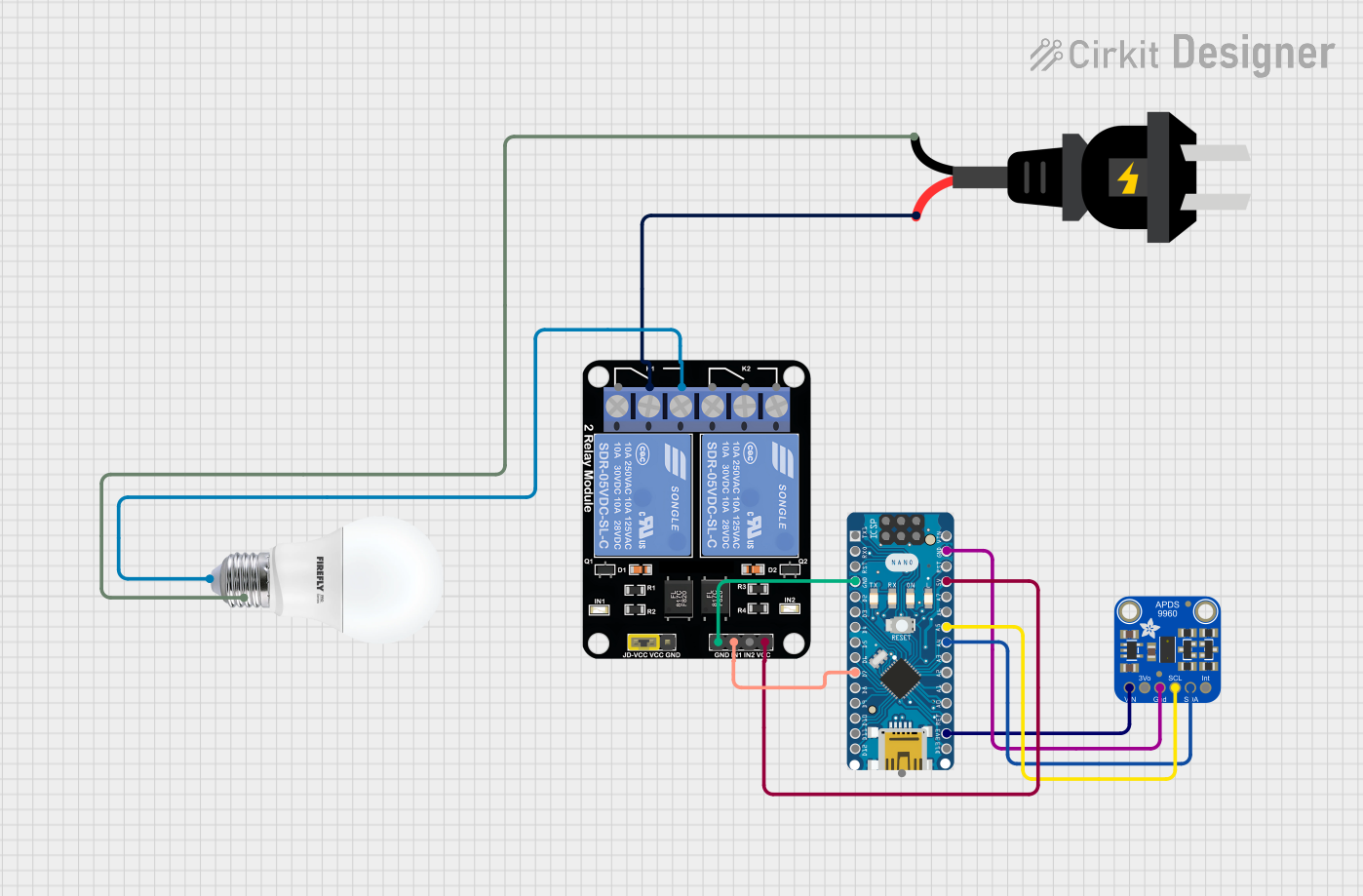
How to Use Adafruit PN532 Breakout: Examples, Pinouts, and Specs

 Design with Adafruit PN532 Breakout in Cirkit Designer
Design with Adafruit PN532 Breakout in Cirkit DesignerIntroduction
The Adafruit PN532 Breakout Board is a versatile and user-friendly NFC/RFID controller that enables wireless communication for a variety of applications. Based on the widely-used PN532 chip, this breakout board is designed to read and write NFC tags, interface with NFC-enabled devices, and facilitate secure transactions. With an onboard 3.3V regulator and level shifting, it is compatible with a broad range of microcontrollers, including both 3.3V and 5V systems, such as the Arduino UNO.
Explore Projects Built with Adafruit PN532 Breakout

 Open Project in Cirkit Designer
Open Project in Cirkit Designer
 Open Project in Cirkit Designer
Open Project in Cirkit Designer
 Open Project in Cirkit Designer
Open Project in Cirkit Designer
 Open Project in Cirkit Designer
Open Project in Cirkit DesignerExplore Projects Built with Adafruit PN532 Breakout

 Open Project in Cirkit Designer
Open Project in Cirkit Designer
 Open Project in Cirkit Designer
Open Project in Cirkit Designer
 Open Project in Cirkit Designer
Open Project in Cirkit Designer
 Open Project in Cirkit Designer
Open Project in Cirkit DesignerCommon Applications and Use Cases
- Contactless payment systems
- Access control
- Identification and authentication
- NFC tag reading and writing
- Peer-to-peer communication between NFC devices
Technical Specifications
Key Technical Details
- Operating Voltage: 3.3V to 5V (with onboard regulator)
- Operating Current: 100mA (typical)
- Frequency: 13.56MHz
- Supported Protocols: ISO/IEC 14443 Type A and B, FeliCa, and MIFARE cards
- Interface: I2C, SPI, and HSU (High-Speed UART)
- Range: Up to 7cm (depending on antenna geometry and card type)
Pin Configuration and Descriptions
| Pin Number | Name | Description |
|---|---|---|
| 1 | VCC | Power supply (3.3V-5V) |
| 2 | GND | Ground connection |
| 3 | SDA | I2C Data / SPI MOSI |
| 4 | SCL | I2C Clock / SPI Clock |
| 5 | MISO | SPI MISO (not used in I2C mode) |
| 6 | IRQ | Interrupt pin (active low) |
| 7 | RSTO | Reset output from PN532 |
| 8 | RSTPD_N | Reset input to PN532 (active low) |
Usage Instructions
How to Use the Component in a Circuit
- Power Connections: Connect VCC to a 3.3V or 5V supply and GND to the ground of your microcontroller.
- Data Connections: Choose between I2C, SPI, or HSU for communication and connect the respective pins to your microcontroller.
- Antenna: Ensure the antenna area is unobstructed for optimal range.
- Reset: Connect RSTPD_N to a digital pin for manual reset control, if required.
Important Considerations and Best Practices
- Use level shifting for 5V microcontrollers to protect the PN532.
- Place the breakout board away from metal surfaces to avoid interference.
- For I2C communication, ensure pull-up resistors are in place if not already provided by your microcontroller.
- Avoid bending the antenna or subjecting it to physical stress.
Example Code for Arduino UNO
#include <Wire.h>
#include <Adafruit_PN532.h>
// If using the I2C interface, define SDA and SCL pins
#define SDA_PIN 2
#define SCL_PIN 3
// Create an instance of the Adafruit_PN532 class
Adafruit_PN532 nfc(SDA_PIN, SCL_PIN);
void setup(void) {
Serial.begin(115200);
Serial.println("Hello! Scan a NFC tag!");
nfc.begin();
uint32_t versiondata = nfc.getFirmwareVersion();
if (!versiondata) {
Serial.print("Didn't find PN53x board");
while (1); // halt
}
// Configure board to read RFID tags
nfc.SAMConfig();
}
void loop(void) {
uint8_t success;
uint8_t uid[] = { 0, 0, 0, 0, 0, 0, 0 }; // Buffer to store the returned UID
uint8_t uidLength; // Length of the UID (4 or 7 bytes depending on ISO14443A card type)
// Wait for an ISO14443A type card (Mifare, etc.). When one is found, 'uid' will be populated
success = nfc.readPassiveTargetID(PN532_MIFARE_ISO14443A, uid, &uidLength);
if (success) {
// Display some basic information about the card
Serial.println("Found an ISO14443A card");
Serial.print("UID Length: ");Serial.print(uidLength, DEC);Serial.println(" bytes");
Serial.print("UID Value: ");
for (uint8_t i=0; i < uidLength; i++) {
Serial.print(" 0x");Serial.print(uid[i], HEX);
}
Serial.println("");
// Wait 1 second before continuing
delay(1000);
}
}
Troubleshooting and FAQs
Common Issues Users Might Face
- No response from the module: Ensure power connections are correct and the microcontroller pins are properly configured.
- Inconsistent tag reads: Check for any obstructions or interference near the antenna area.
- Communication errors: Verify the correct interface (I2C/SPI/HSU) is selected and properly connected.
Solutions and Tips for Troubleshooting
- Double-check wiring, especially the SDA and SCL lines for I2C, and MOSI, MISO, and SCK for SPI.
- Ensure the library used matches the communication protocol selected.
- Reset the PN532 module using the RSTPD_N pin if the module becomes unresponsive.
FAQs
Q: Can the Adafruit PN532 Breakout Board be used with a 5V microcontroller like an Arduino UNO?
A: Yes, the board has a built-in level shifter and regulator, making it compatible with 5V systems.
Q: What is the maximum range of the NFC communication?
A: The maximum range is up to 7cm, but this can vary based on antenna design and environmental factors.
Q: How do I know if the board is powered and functioning correctly?
A: Upon powering up, the board's firmware version can be read as a basic check. If the firmware version is returned, the board is functioning correctly.
Q: Can the board read all types of NFC tags?
A: The board supports a wide range of NFC tags, including ISO/IEC 14443 Type A and B, FeliCa, and MIFARE cards. However, compatibility with all NFC tag types is not guaranteed.